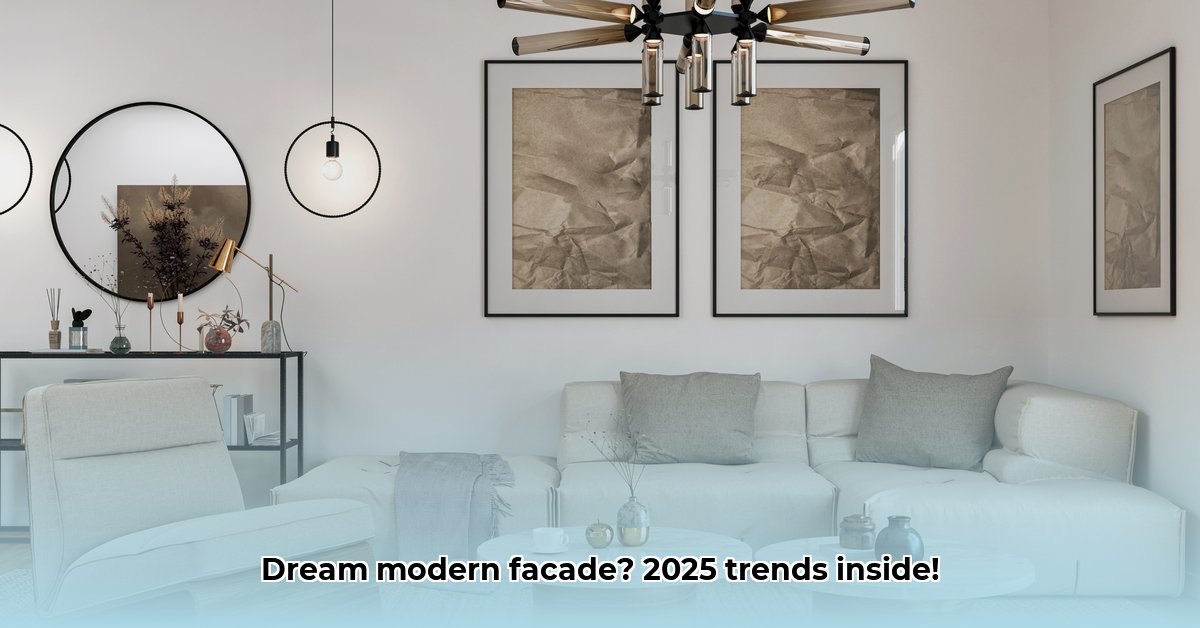Want a home exterior that wows? This guide is your roadmap to designing a stunning contemporary modern facade. We’ll walk you through the latest trends for 2025, covering everything from materials and costs to long-term care and eco-friendly choices. Forget confusing jargon – we’ll make it easy to understand the process, step by step. You’ll learn how to pick the perfect materials, figure out what it’ll all cost, and make smart choices that look great and last. Whether you’re aiming for a minimalist look or something that fits your local style and the planet, we’ve got the practical tips and tricks to turn your house into a showstopper. For more ideas, check out this modern facade design guide. Let’s build your dream facade together!
Contemporary Modern House Facade Design Trends and Architectural Innovation
Designing your dream home’s exterior is exciting! Let’s explore the hottest trends in contemporary modern house facade design for 2025 and beyond, focusing on creating a look that’s both stylish and practical. We’ll go beyond just pretty pictures and delve into the how-to, helping you build your dream facade with innovative architectural details and design techniques.
Minimalism Evolved: Texture, Warmth, and Biophilic Design
Clean lines and expansive windows remain core tenets of contemporary modern design, but 2025 elevates minimalism with texture, warmth, and biophilic elements. Instead of stark, sterile spaces, think natural materials, layered textures, and design that connects you to the outdoors. Consider incorporating wood cladding, stone accents, or even textured concrete to add depth and visual interest to your facade. Large windows not only flood the interiors with natural light but also frame views of nature, seamlessly blending the indoors and outdoors. Biophilic design principles further enhance this connection by incorporating greenery, water features, or natural patterns into the facade itself.
Material Palette Expansion: Moving Beyond Neutrals
While neutral colors still dominate modern facades, 2025 is seeing a rise in bolder and more expressive color palettes. Earthy tones like warm grays, muted greens, and terracotta are gaining popularity, bringing a sense of natural warmth and sophistication. Accents of bronze, copper, or even dark blues can add depth and create visual interest. The key is to use color thoughtfully and strategically, ensuring that it complements the architectural style and surrounding environment. Explore using a color consultant to achieve perfect balance.
Sustainable Materials: Performance and Beauty Combined
Sustainability is no longer a trend but a core principle of modern design. In 2025, expect to see even greater emphasis on eco-friendly materials that offer both high performance and aesthetic appeal. Recycled wood, bamboo, and eco-concrete are becoming increasingly popular, alongside innovative materials like mycelium and reclaimed plastic. Consider incorporating solar panels seamlessly into the facade, turning your home into a renewable energy source. Living walls and green roofs not only add visual interest but also improve air quality and reduce urban heat island effect.
Smart Technology Integration: Enhanced Functionality and Efficiency
Smart technology is transforming the way we interact with our homes, and the facade is no exception. Smart lighting systems can adjust automatically based on time of day or weather conditions, enhancing security and energy efficiency. Smart windows can tint to control sunlight and heat gain, reducing reliance on air conditioning. Integrated security systems with facial recognition and remote access provide enhanced peace of mind. These technologies not only improve the functionality of the facade but also add a touch of modern sophistication.
Climate-Responsive Design: Optimizing Comfort and Energy Efficiency
Climate plays a crucial role in facade design, and 2025 sees a greater emphasis on climate-responsive strategies. In hot climates, consider incorporating shading devices like overhangs, louvers, or screens to reduce solar heat gain. In cold climates, focus on maximizing solar gain through large south-facing windows and high-performance insulation. Natural ventilation strategies can also help regulate temperature and improve indoor air quality. By carefully considering the local climate, you can create a facade that is both beautiful and energy-efficient.
Prefabrication and Modular Construction: Speed, Precision, and Sustainability
Prefabrication and modular construction are gaining traction in modern facade design, offering numerous benefits including faster construction times, improved quality control, and reduced waste. Prefabricated facade panels can be manufactured off-site in controlled environments, ensuring precise dimensions and high-quality finishes. Modular construction allows for flexible and customizable designs, while minimizing disruption to the surrounding environment. These techniques are particularly well-suited for complex and innovative facade designs.
Your Step-by-Step Guide to a Dream Facade
Here’s a simple plan to turn your dream facade into reality with these actionable steps:
-
Inspiration Gathering: Immerse yourself in design inspiration. Explore online platforms like Pinterest, Houzz, and ArchDaily. Gather images from magazines, books, and even your travels. Pay attention to architectural details, material combinations, and overall design aesthetics that resonate with you.
-
Define Your Style: Clarify your design preferences. Are you drawn to minimalist simplicity, industrial chic, or natural warmth? Creating a mood board can help you visualize your desired aesthetic and communicate your vision to professionals.
-
Professional Consultation – Architect and Design-Build Team: Partner with qualified professionals. Engage an architect to develop a detailed design plan that aligns with your style, budget, and local building codes. Consider working with a design-build team to streamline the process and ensure seamless execution.
-
Budgeting and Material Selection: Establish a realistic budget. Research the costs of different materials and finishes. Explore sustainable and cost-effective alternatives without compromising on style or quality.
-
Permitting and Approvals: Navigate the regulatory landscape. Work with your architect or contractor to obtain all necessary permits and approvals from your local building department, ensuring compliance with zoning regulations and building codes.
-
Construction and Installation: Oversee the construction process. Regularly communicate with your contractor to ensure that the facade is being built according to the design specifications and quality standards.
-
Enjoy Your Masterpiece!: Step back and admire your unique, stylish home exterior. You’ve created something truly special, reflecting current design trends.
Popular Facade Materials: Weighing the Pros and Cons
| Material | Advantages | Disadvantages |
|---|---|---|
| Natural Stone | Durable, elegant, timeless, high resale value, natural insulation | Expensive, high maintenance, potential cracking, heavy |
| Render/Stucco | Affordable, versatile, easy maintenance, many colors, good insulation | Less durable than stone, susceptible to cracking, can require periodic repair |
| Wood Cladding | Warm, inviting, organic texture, sustainable if sourced responsibly | Requires regular maintenance, potential rot/insect damage, fire risk |
| Metal Cladding | Modern, low maintenance, durable, lightweight, recyclable | Can be expensive, may require specialized cleaning, can dent |
| Brick | Durable, low maintenance, fire resistant, classic aesthetic | Can be expensive, limited color options, can absorb moisture |
| Composite Materials | Durable, low maintenance, weather resistant, wide range of styles and colors | Can be expensive, may not be as aesthetically pleasing as natural materials |
Remember, your home’s exterior is the first impression – make it count. Designing your contemporary modern house facade is a journey, not a race. Take your time, explore the options, and work with professionals to build the home of your dreams with innovative designs.
How to Choose Sustainable Materials for a Modern House Facade
Key Takeaways:
- Sustainable facade materials significantly reduce a building’s environmental impact, contributing to green initiatives.
- Careful consideration of lifecycle assessments (LCAs) is crucial for informed decision-making, encompassing environmental impact analysis and material life assessment.
- Numerous eco-friendly options exist, each with unique strengths and weaknesses, providing diverse material choices.
- Regional climate, building design, and long-term costs significantly influence material selection, ensuring sustainable design principles.
- Understanding local building codes and regulations is essential for compliance, ensuring legal and environmental adherence.
Embracing Sustainability in Modern Facade Design through Eco-Friendly Materials
Designing a stunning modern home facade in 2025 isn’t just about aesthetics; it’s about responsibility. How to choose sustainable materials for a modern house facade is a question many homeowners are asking. Sustainable materials not only lessen your environmental footprint but also contribute to a healthier living space and often lower long-term costs. What sustainable choices can elevate your home’s look? Let’s dive into the key considerations.
Understanding Lifecycle Assessments (LCAs) for Eco-Conscious Building Materials
Before selecting any material, understanding its lifecycle is vital. A comprehensive LCA assesses the environmental impact from raw material extraction to manufacturing, transportation, installation, use, and eventual disposal or recycling. This holistic view helps you identify truly sustainable choices. Think of it as the material’s complete environmental story.
Exploring Sustainable Material Options and Environmentally Friendly Finishes
The market offers a diverse range of sustainable materials. Here are a few popular options that reflect current eco-friendly trends:
-
Recycled Materials: Reclaimed wood, recycled steel, and repurposed brick offer impressive aesthetic appeal while reducing landfill waste. They often boast a unique character, adding charm to your home through innovative recycling techniques.
-
Bio-Based Composites: Hempcrete (a mixture of hemp fibers and lime) and mycelium (a mushroom-based material) are increasingly popular, reflecting the rise of sustainable building options. These options are rapidly renewable and
- Glass Tile Shower Ideas to Create a Stunning Bathroom Space - December 7, 2025
- Glass Wall Tile Ideas for Kitchens and Bathrooms - December 6, 2025
- Glass Tile Bathroom: Create a Beautiful, Easy-Clean Space - December 5, 2025










